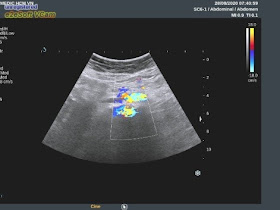Male patient 60yo with lower GI tract hemorrhagia for months. At local hospital rectal endoscopy noted rectal wall rigid invasion. Biopsy results showed rectal ulcerative inflammation with anaplastic inversion.

Abdominal MSCT= Rectal wall lesion thickening #18mm captured contrast in medium intensity and degraded fatty tissue around . Some mesenteric nodes 5-10mm. Being thought about rectal tumor invading tissue around and metastasing to nodes.
-
- Pelvic MRI= Invaded pattern tumor is inside rectum # 82mm which made narrowing rectal lumen that is far from anus #46mm and invaded muscular layer toward posterior wall of rectum and presacral area from S2 to coccyx and adhered posterior prostatic urethra wall. Gado captured non similarly with high signal intensity on T2W1, medium signal intensity on T1W1. Some 10-16mm nodes existed around rectum.
- Intraluminal rectal ultrasound with probe ASU-67, 7.5-10MHz, views 360 degree detects rectal tumor far from anus 30-40mm. Tumor takes place entirely rectum and outside = invaded anterior sacrum posteriorly and adhered prostate and prostatic urethra anteriorly. Existing some 5-7mm nodes nearby tumor.
- Endoscopy of rectum revealed rectal ulcerative invasive lesions that made narrowing rectal lumen. Biopsy results is poor differentiated adenocarcinoma, type ring cell of rectum.
Chemotherapy is on going for patient at Binh dan hospital.
CONCLUSION=
Intraluminal rectal ultrasound by probe view 360 degree is useful to assess rectal wall lesion and around rectum tissue, taking
part to detect rectum and rectal canal disorders.























